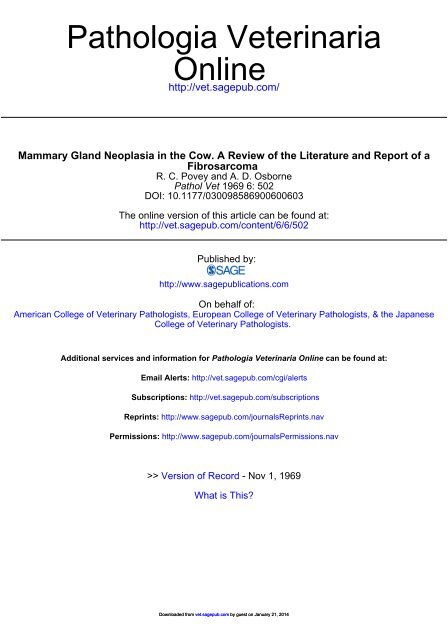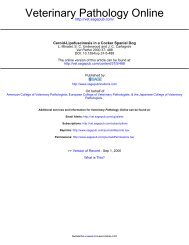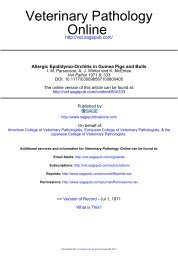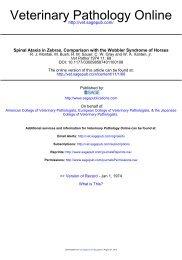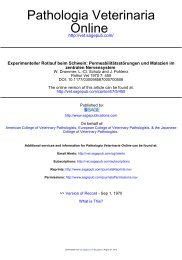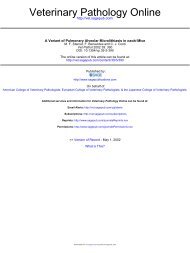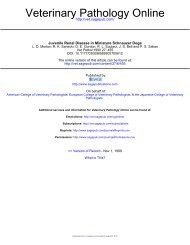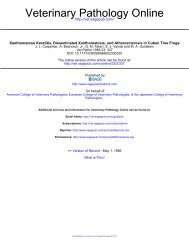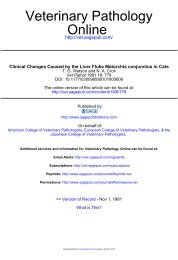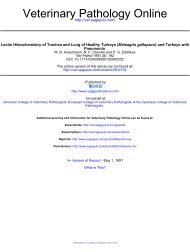Mammary Gland Neoplasia in the Cow - Veterinary Pathology
Mammary Gland Neoplasia in the Cow - Veterinary Pathology
Mammary Gland Neoplasia in the Cow - Veterinary Pathology
You also want an ePaper? Increase the reach of your titles
YUMPU automatically turns print PDFs into web optimized ePapers that Google loves.
Pathologia Veter<strong>in</strong>aria<br />
Onl<strong>in</strong>e<br />
http://vet.sagepub.com/<br />
<strong>Mammary</strong> <strong>Gland</strong> <strong>Neoplasia</strong> <strong>in</strong> <strong>the</strong> <strong>Cow</strong>. A Review of <strong>the</strong> Literature and Report of a<br />
Fibrosarcoma<br />
R. C. Povey and A. D. Osborne<br />
Pathol Vet 1969 6: 502<br />
DOI: 10.1177/030098586900600603<br />
The onl<strong>in</strong>e version of this article can be found at:<br />
http://vet.sagepub.com/content/6/6/502<br />
Published by:<br />
http://www.sagepublications.com<br />
On behalf of:<br />
American College of Veter<strong>in</strong>ary Pathologists, European College of Veter<strong>in</strong>ary Pathologists, & <strong>the</strong> Japanese<br />
College of Veter<strong>in</strong>ary Pathologists.<br />
Additional services and <strong>in</strong>formation for Pathologia Veter<strong>in</strong>aria Onl<strong>in</strong>e can be found at:<br />
Email Alerts: http://vet.sagepub.com/cgi/alerts<br />
Subscriptions: http://vet.sagepub.com/subscriptions<br />
Repr<strong>in</strong>ts: http://www.sagepub.com/journalsRepr<strong>in</strong>ts.nav<br />
Permissions: http://www.sagepub.com/journalsPermissions.nav<br />
>> Version of Record - Nov 1, 1969<br />
What is This?<br />
Downloaded from vet.sagepub.com<br />
by guest on January 21, 2014
Path. vet. 6: 502-512 (1969)<br />
From <strong>the</strong> Department of Veter<strong>in</strong>ary Medic<strong>in</strong>e, University of Bristol, Bristol<br />
<strong>Mammary</strong> <strong>Gland</strong> <strong>Neoplasia</strong> <strong>in</strong> <strong>the</strong> <strong>Cow</strong><br />
A Review of <strong>the</strong> Literature and Report of a Fibrosarcoma<br />
R.C. POVEY and A.D. OSBORNE<br />
<strong>Mammary</strong> gland neoplasms, so common <strong>in</strong> <strong>the</strong> bitch, are very rare <strong>in</strong> <strong>the</strong> cow.<br />
SWETT, et al.40 exam<strong>in</strong>ed <strong>in</strong> considerable detail <strong>the</strong> udders of 313 cows of lactat<strong>in</strong>g<br />
age and of 105 heifers and freemart<strong>in</strong>s. Of <strong>the</strong> lactat<strong>in</strong>g cows, 31% were 8 years of<br />
age, or more, and this <strong>the</strong>y considered to be beyond <strong>the</strong> ‘cancer age’, but <strong>in</strong> no <strong>in</strong>stance<br />
was a neoplastic change noted.<br />
In 1945 <strong>the</strong> UNITED STATES DEPARTMENT OF<br />
reported that<br />
some 13 million bov<strong>in</strong>e udders were subjected to rout<strong>in</strong>e <strong>in</strong>spection, but none was<br />
found to conta<strong>in</strong> a tumour. The surveys of COT CHIN^^ <strong>in</strong> <strong>the</strong> United K<strong>in</strong>gdom,<br />
PLUMMER~~ <strong>in</strong> Canada, JACKSONZ4 <strong>in</strong> South Africa, MISDORP~~ <strong>in</strong> <strong>the</strong> Ne<strong>the</strong>rlands,<br />
and NAIR and SASTRY~~ <strong>in</strong> India cover 2,999 bov<strong>in</strong>e neoplasms of which only 11<br />
<strong>in</strong>volve <strong>the</strong> udder (PLUMMER 1 ; MISDOKP 1 ; NAIR and SASTRY 9,8 of which were<br />
<strong>in</strong>tracanalicular fibromatous polyps). Tumours of <strong>the</strong> udder can be divided <strong>in</strong>to<br />
a primary group of ei<strong>the</strong>r glandular, ductular, or stromal elements; primary cutaneous<br />
tumours which directly <strong>in</strong>vade <strong>the</strong> udder, e.g. melanomas2- or squamous<br />
cell carc<strong>in</strong>omasl4- 15; and secondary metastatic tumours, e. g. lymphosar~oma~~ 26.<br />
Previous reports of bov<strong>in</strong>e primary mammary neoplasms are listed <strong>in</strong> Table I.<br />
Many of <strong>the</strong>se reports are sketchy and <strong>in</strong>adequate. For <strong>the</strong> above reasons, our case<br />
of a suspected fibrosarcoma, with mult<strong>in</strong>ucleate giant cells as an unusual feature <strong>in</strong><br />
some areas, is recorded.<br />
Case History<br />
A 4-year-old Ayrshire cow, which had calved 3 months previously, had<br />
steadily lost condition s<strong>in</strong>ce calv<strong>in</strong>g. Hepatic fascioliasis was diagnosed and treated<br />
but weight loss cont<strong>in</strong>ued and milk yield dim<strong>in</strong>ished. It was only 10 days before<br />
admission that <strong>in</strong>duration of <strong>the</strong> udder was noted and a febrile reaction (105°F)<br />
detected. Treatment with oxytetracycl<strong>in</strong>e hydrochloride* <strong>in</strong>tramuscularly for 4<br />
days was without effect. Staphylococcm pyogenes was cultured from <strong>the</strong> milk.<br />
When admitted to this department <strong>the</strong> animal was grossly emaciated. The<br />
temperature was 105°F and pulse and respiratory rate were raised. The udder,<br />
* Terramyc<strong>in</strong> soluble. Pfizer Limited.<br />
Downloaded from vet.sagepub.com by guest on January 21, 2014
uble 1. Reports of primary mammary neoplasms <strong>in</strong> <strong>the</strong> cow<br />
Date Author Breed Age Diagnosis as made by author<br />
1902<br />
1903<br />
1906<br />
1908<br />
1908<br />
1909<br />
1910<br />
1912<br />
-<br />
1934<br />
1942<br />
1948<br />
1953<br />
1954<br />
1955<br />
1956<br />
1959<br />
1965<br />
1966<br />
1967<br />
STICKER<br />
KUHN*<br />
BOUCEK<br />
CLELAND<br />
MURRAY<br />
TROTTER<br />
JOEST*<br />
SCHLEGEL*<br />
KITT*<br />
HYNES<br />
KENNY<br />
JULIAN<br />
NAIR and SASTRY<br />
ELDER, KINTNER<br />
and JOHNSON<br />
RENK<br />
PLUMXER<br />
HOFMEYR<br />
ROTHENBACITER<br />
MONTRONI<br />
~IISDORP<br />
-<br />
-<br />
-<br />
-<br />
Highland<br />
-<br />
-<br />
-<br />
Shorthorn<br />
Shorthorn<br />
Holste<strong>in</strong>-Friesian 9<br />
- -<br />
Aberdeen Angus 3<br />
Hohenfleck 5<br />
Jersey -<br />
Holste<strong>in</strong>-Friesian 16<br />
1969 POVEY and OSBORNE Avrshire 4<br />
* Cited by FREI’~.<br />
** m = macroscopic illustration<br />
h = microscopic illustration<br />
Angioma<br />
Adenocarc<strong>in</strong>oma : metastases <strong>in</strong> <strong>in</strong>t. iliac lymph<br />
nodes, lungs, and bronchial L.N.<br />
Papilloma<br />
Fibro-adeno-carc<strong>in</strong>oma<br />
Unclassified carc<strong>in</strong>oma<br />
‘hlammary tumour’<br />
‘Intracanalicular papilliferous fibroma’<br />
Fibroma<br />
Adenofibroma<br />
Osteoma<br />
Unclassified ‘cancer’<br />
Adenocarc<strong>in</strong>oma : metastases <strong>in</strong> sup ram am mar^^<br />
L.N., liver, lungs; possibly <strong>in</strong> bronchial and<br />
mediast<strong>in</strong>al L.N. and diaphragm<br />
hlultiple fibrous polyps of cistern wall<br />
Squamous cell carc<strong>in</strong>oma of milk ducts<br />
Undifferentiated carc<strong>in</strong>oma; metastases <strong>in</strong> both<br />
supramammaries and left prefemoral L.N.<br />
Papillarv cvst-adenonia <strong>in</strong>volv<strong>in</strong>g whole L.H.<br />
quarter<br />
Fibroma<br />
‘Sp<strong>in</strong>dle-cell’ sarcoma<br />
Adenocarc<strong>in</strong>oma with metastases <strong>in</strong> supramammary,<br />
iliac, and renal L.N.<br />
‘<strong>Gland</strong>ular cystic carc<strong>in</strong>oma’<br />
Adenocarc<strong>in</strong>oma with metastases <strong>in</strong> superficial<br />
and deep <strong>in</strong>gu<strong>in</strong>al L.N., lungs, pleura, pericardium,<br />
and kidney<br />
Fibrosarcoma with mult<strong>in</strong>ucleate giant cells<br />
histopathology Illus.**<br />
Studied Described<br />
-<br />
?<br />
?<br />
+<br />
+<br />
+<br />
-<br />
?<br />
?<br />
?<br />
+<br />
+<br />
+<br />
+<br />
+<br />
+<br />
-<br />
wl<br />
0 w<br />
~ -<br />
Downloaded from vet.sagepub.com by guest on January 21, 2014
504 POVEY/OSBORNE<br />
swollen to <strong>the</strong> size of that of a newly-calved heavy milker, contrasted markedly<br />
with <strong>the</strong> general emaciation. Palpation <strong>in</strong>dicated a firmer than usual consistency of<br />
all quarters, but <strong>the</strong>re was a softer area <strong>in</strong> <strong>the</strong> region of <strong>the</strong> supramammary lymph<br />
nodes. The subcutaneous abdom<strong>in</strong>al (‘milk’) ve<strong>in</strong>s were engorged. No abnormality<br />
was detected on rectal exam<strong>in</strong>ation.<br />
Among cl<strong>in</strong>ical pathological f<strong>in</strong>d<strong>in</strong>gs were a few fluke eggs <strong>in</strong> <strong>the</strong> faeces,<br />
a mild anaemia, and serum glutamic oxalacetic transam<strong>in</strong>ase (SGOT) activity of<br />
124 pg pyruvate/ml (normal 56 5 148). S. progenes was isolated from <strong>the</strong> milk of all<br />
quarters but <strong>in</strong> low numbers except for <strong>the</strong> left h<strong>in</strong>d from which a moderate<br />
growth was obta<strong>in</strong>ed. Cultures for yeasts were negative, as were smears for acidfast<br />
organisms. Treatment with 1 g of oxytetracycl<strong>in</strong>e ijv was <strong>in</strong>stituted for 4 days<br />
with a lower<strong>in</strong>g of temperature to 101.5’F and of pulse, and improvement of<br />
appetite. On <strong>the</strong> morn<strong>in</strong>g of <strong>the</strong> 5th day, however, <strong>the</strong> cow was found ‘down’ and<br />
<strong>in</strong> view of its state euthanasia was performed.<br />
Postmortal F<strong>in</strong>d<strong>in</strong>gs<br />
The peritoneal cavity conta<strong>in</strong>ed some clear transudate. The liver had typical<br />
lesions of chronic fascioliasis and numerous young and adult Fasciola hepatica. The<br />
mammary gland weighed approximately 20 kg. It was firm to hard but somewhat<br />
softer dorso-posteriorly. A large tumour (approx. 45 x 40 x 25 cm dorso-ventrally)<br />
occupied <strong>the</strong> major part of <strong>the</strong> udder. Peripherally <strong>the</strong>re were large lobules of<br />
yellow-white, firm, relatively homogeneous tissue with necrosis which grew progressively<br />
more severe towards <strong>the</strong> centre, and with massive haemorrhage <strong>in</strong> <strong>the</strong><br />
actual centre, yield<strong>in</strong>g not less than 2 litres of blood and clots. There was a sharp<br />
demarcation between <strong>the</strong> tumour and normal mammary tissue. The forequarters<br />
were compressed ra<strong>the</strong>r more than <strong>the</strong> h<strong>in</strong>d-quarters, <strong>the</strong> left of which had some<br />
haemorrhage and oedema. The supramammary lymph nodes were oedematous.<br />
No metastasis of <strong>the</strong> tumour was found.<br />
Histopathology<br />
Specimens for histology were taken from <strong>the</strong> apparently more normal tissue<br />
of each of <strong>the</strong> mammary quarters and from <strong>the</strong> tumour, at its periphery adjacent to<br />
<strong>the</strong> sub-pelvic fascia, <strong>in</strong> 1 area where it abutted onto <strong>the</strong> more normal mammary<br />
tissue, and from its more central friable part. Blocks of tissue were fixed for 24 h<br />
<strong>in</strong> 5% formol-sal<strong>in</strong>e solution and paraff<strong>in</strong>-embedded sections werc cut and sta<strong>in</strong>ed<br />
by haematoxyl<strong>in</strong> and eos<strong>in</strong>, Masson’s green trichrome, Gomori’s reticul<strong>in</strong>, Ziehl-<br />
Neelsen’s, Gram’s, periodic acid-Schiff, and Grocott’s methods. Some material<br />
was fixed <strong>in</strong> cold acetone and sta<strong>in</strong>ed for alkal<strong>in</strong>e phosphatase by GOMORI’S<br />
method20.<br />
Fig. I. Typical area of tumour show<strong>in</strong>g pleomorphism of cells with mitotic figure,<br />
and several bi- and tri-nucleate forms. Masson’s green trichrome.<br />
Fig. 2. Sub-peripheral area of tumour where <strong>the</strong>re are numerous mult<strong>in</strong>ucleate<br />
giant cells, many of which are vacuolated with some conta<strong>in</strong><strong>in</strong>g apparently<br />
phagocytosed material. Masson’s green trichrome.<br />
Downloaded from vet.sagepub.com by guest on January 21, 2014
hlammary <strong>Gland</strong> <strong>Neoplasia</strong> <strong>in</strong> <strong>the</strong> <strong>Cow</strong> 505<br />
Downloaded from vet.sagepub.com by guest on January 21, 2014
506 POVEY/~SBORNE<br />
The periphery of <strong>the</strong> tumour was well demarcated dorsally by dense collagenous<br />
tissue of <strong>the</strong> deep abdom<strong>in</strong>al fascia <strong>in</strong> which was <strong>in</strong>corporated a th<strong>in</strong> strip<br />
of striated muscle and ventro-laterally by th<strong>in</strong> but fairly dense collagenous septa<br />
from normal glandular tissue. The neoplastic tissue was densely cellular, with <strong>the</strong><br />
typical cell ra<strong>the</strong>r ellipsoid, averag<strong>in</strong>g 20 by 15 ,LA, with a central round or oval<br />
nucleus with sharp nuclear membrane, stippl<strong>in</strong>g of chromat<strong>in</strong>, and a variable<br />
number of small nucleoli (Fig. 1). The cytoplasm was eos<strong>in</strong>ophilic and tended to<br />
be drawn out <strong>in</strong>to stellate strands, l<strong>in</strong>k<strong>in</strong>g up with <strong>the</strong> cytoplasmic processes of<br />
neighbour<strong>in</strong>g cells. Mitotic figures were few <strong>in</strong> number (averag<strong>in</strong>g 1 per 10 fields<br />
at 320 x magnification). A strik<strong>in</strong>g feature was <strong>the</strong> large number of mult<strong>in</strong>ucleate<br />
giant cells with up to 30 nuclei, sometimes very hyperchromatic, which tended to<br />
be conglomerated towards <strong>the</strong> centre of <strong>the</strong> cell ra<strong>the</strong>r than around its periphery.<br />
Approximately 20% of <strong>the</strong>se mult<strong>in</strong>ucleate cells were vacuolated (Fig. 2, 3). Unfortunately<br />
no fat sta<strong>in</strong> was carried out and <strong>the</strong>se vacuoles could not be identified<br />
fur<strong>the</strong>r. However, some vacuoles conta<strong>in</strong>ed well-sta<strong>in</strong>ed material suggest<strong>in</strong>g a<br />
possible phagocytic property of at least some of <strong>the</strong> giant cells. The tumour was<br />
moderately vascular, with some of <strong>the</strong> venules <strong>in</strong>vaded by tumour cells. Its stroma<br />
was of f<strong>in</strong>e collagen <strong>in</strong> a pericellular arrangement. Reticul<strong>in</strong>-sta<strong>in</strong><strong>in</strong>g revealed a<br />
meshwork of argyrophilic fibres surround<strong>in</strong>g each cell (Fig. 3).<br />
Fig. 3. Peripheral area of tumour. Giant cells, some vacuolated, have many densely<br />
sta<strong>in</strong><strong>in</strong>g nuclei, and are surrounded by a meshwork of argyrophil fibres.<br />
Gomori’s reticul<strong>in</strong> sta<strong>in</strong>.<br />
Downloaded from vet.sagepub.com by guest on January 21, 2014
Fig. 4. Pericentral area of tumour <strong>in</strong>dicat<strong>in</strong>g degree of cellularity, pleomorphism,<br />
and whorl<strong>in</strong>g pattern. Masson’s green trichrome.<br />
F%. 5. Similar area to Fig. 4, show<strong>in</strong>g pericellular network of argyrophil fibres.<br />
Gomori’s reticul<strong>in</strong> sta<strong>in</strong>.<br />
Downloaded from vet.sagepub.com by guest on January 21, 2014
508 POVEY/OSBORNE<br />
More centrally <strong>the</strong>re were noticeably fewer giant cells, and those present had<br />
fewer nuclei. The cell type was more typically sp<strong>in</strong>dle shaped and <strong>the</strong>re was a<br />
def<strong>in</strong>ite tendency for stream<strong>in</strong>g and whorl<strong>in</strong>g patterns to be formed (Fig. 4, 5).<br />
Mitotic figures were more frequent.<br />
At <strong>the</strong> edge of <strong>the</strong> central cavity with blood clots and tissue debris <strong>the</strong>re<br />
was disruption of vessel walls with haemorrhage. In o<strong>the</strong>r vessels <strong>the</strong>re were<br />
thrombi with numerous white cells many of which were eos<strong>in</strong>ophils.<br />
The more nearly normal udder was a recently active gland beg<strong>in</strong>n<strong>in</strong>g to <strong>in</strong>volute.<br />
Adjacent to <strong>the</strong> tumour, although well separated by collagenous tissue,<br />
<strong>the</strong>re was pressure collapse of <strong>the</strong> ac<strong>in</strong>i. There were some foci of plasma cells,<br />
neutrophils, and eos<strong>in</strong>ophils <strong>in</strong> <strong>the</strong> <strong>in</strong>terstitium.<br />
The tumour was negative for alkal<strong>in</strong>e phosphatase when sta<strong>in</strong>ed by GOMORI’S<br />
modified method, whereas apparently normal udders gave a positive reaction.<br />
Myoepi<strong>the</strong>lial cells are particularly rich <strong>in</strong> this enzyme13.<br />
The tumour’s cell type and its pattern of growth, particularly as seen <strong>in</strong> <strong>the</strong><br />
deeper parts with <strong>the</strong> collagenous and reticul<strong>in</strong> networks, were considered typical<br />
of a fibroblastic neoplasm. In view of its cellularity, and peripherally more disorganised<br />
structure, with <strong>the</strong> numerous giant cells, it was classified as a fibrosarcoma<br />
ra<strong>the</strong>r than a fibroma, although <strong>the</strong>re was no evidence of any metastasis <strong>in</strong> <strong>the</strong><br />
supramammary lymph nodes, or elsewhere.<br />
The possibility of <strong>the</strong> lesion be<strong>in</strong>g basically an <strong>in</strong>fective granuloma was considered,<br />
but nei<strong>the</strong>r bacterium, yeast, nor fungus, was found <strong>in</strong> <strong>the</strong> histological<br />
sections.<br />
Discussion<br />
KENNY27, <strong>in</strong> a complete account of a primary adenocarc<strong>in</strong>oma of a bov<strong>in</strong>e<br />
udder, considered <strong>the</strong> rarity of neoplasia of <strong>the</strong> mammary gland <strong>in</strong> <strong>the</strong> cow difficult<br />
to expla<strong>in</strong>, ‘especially when one considers <strong>the</strong> demands which are made on this<br />
organ by present-day <strong>in</strong>tensive methods of milk production, its proneness to<br />
chronic mastitis, and <strong>the</strong> fact that <strong>the</strong> dairy cow, unlike <strong>the</strong> majority of bov<strong>in</strong>es is<br />
as a rule allowed to live well beyond what is described as <strong>the</strong> ‘cancer age”. ANDER-<br />
SON and JARRETT~ suggested, however, that as <strong>in</strong> women lactation is known to<br />
protect aga<strong>in</strong>st mammary neoplasia, <strong>the</strong> almost constant lactation <strong>in</strong> cows may<br />
afford similar protection. FIDLER, ABT, and BRODEY’S postulated that excessive progesterone<br />
stimulation with recurrent milk retention be <strong>the</strong> key to <strong>the</strong> high <strong>in</strong>cidence<br />
of mammary neoplasia <strong>in</strong> <strong>the</strong> bitch. RENK~~ described how cysts of various<br />
sizes could be found <strong>in</strong> <strong>the</strong> glandular tissue <strong>in</strong> cases of chronic bov<strong>in</strong>e mastitis,<br />
which he likened to ‘mastopathia cystica’ <strong>in</strong> man. In 1 case he described such change<br />
proceed<strong>in</strong>g to neoplasia <strong>in</strong> <strong>the</strong> form of a papillary cyst-adenoma. ROTHENBACHERS6<br />
suspected that some cases which were diagnosed as chronic bov<strong>in</strong>e mastitis may<br />
have been neoplastic <strong>in</strong> nature.<br />
Pure fibrosarcoma of <strong>the</strong> mammary gland, <strong>in</strong> <strong>the</strong> dog at least, is much less<br />
common than mixed or glandular tumours. Thus SMITH and JONES.~~ <strong>in</strong> <strong>the</strong>ir compilation<br />
of tumours from various surveys <strong>in</strong>cluded 934 can<strong>in</strong>e mammary tumours<br />
of which only 19 were fibromata or fibrosarcomata. In <strong>the</strong> cow, as far as we are<br />
aware, apart from <strong>in</strong>tercanalicular fibromatad1 and cisternal fibrous polyps25, <strong>the</strong>re<br />
Downloaded from vet.sagepub.com by guest on January 21, 2014
<strong>Mammary</strong> <strong>Gland</strong> <strong>Neoplasia</strong> <strong>in</strong> <strong>the</strong> <strong>Cow</strong> 509<br />
is only HOFMEYR’S report?’ of a ‘sp<strong>in</strong>dle-cell sarcoma’ <strong>in</strong> a Jersey cow which <strong>in</strong>volved<br />
much of <strong>the</strong> left side of <strong>the</strong> udder, was some 22 cm <strong>in</strong> diameter, and had a<br />
necrotic centre. This tumour HOFMEYR successfully removed by complete mastectomy.<br />
A noteworthy feature of this present fibrosarcoma was <strong>the</strong> extremely high<br />
<strong>in</strong>cidence of mult<strong>in</strong>ucleate giant cells. € 3 0 classifies ~ ~ ~ giant cells <strong>in</strong>to 3 types:<br />
tumour giant cells ; foreign-body giant cells, characterised by be<strong>in</strong>g phagocytic; and<br />
a miscellaneous group <strong>in</strong>clud<strong>in</strong>g <strong>the</strong> Reed-Sternberg cell of Hodgk<strong>in</strong>’s disease <strong>in</strong><br />
man. In foreign-body mult<strong>in</strong>ucleate cells, <strong>the</strong> nuclei tend to form a peripheral<br />
palisade, whereas <strong>in</strong> <strong>the</strong> tumour giant cell, as <strong>in</strong> <strong>the</strong> above case, <strong>the</strong> nuclei are<br />
ei<strong>the</strong>r diffuse with<strong>in</strong> <strong>the</strong> cytoplasm or tend to aggregate centrally. Giant cells can<br />
occur <strong>in</strong> virtually any type of tumour, but EvA~sl~, <strong>in</strong> <strong>the</strong> case of human fibrosarcomata<br />
at least, states that although mult<strong>in</strong>ucleated cells may be found <strong>the</strong>y<br />
are not a spectacular feature, and <strong>in</strong>deed Srou~38 considers <strong>the</strong>m exceed<strong>in</strong>gly uncommon.<br />
WILL IS^^ on <strong>the</strong> o<strong>the</strong>r hand writes that <strong>the</strong> more undifferentiated fibrosarcomata<br />
often <strong>in</strong>clude many giant and mult<strong>in</strong>ucleated tumour cells.<br />
We have reviewed 50 tumours diagnosed as fibrosarcoma at this school over<br />
<strong>the</strong> past 10 years, and <strong>in</strong> only 2-1 dog (a metastatic fibrosarcoma <strong>in</strong> <strong>the</strong> liver), and<br />
1 horse (a sub-cutaneous neoplasm) were giant cells easily found. Giant cells were<br />
not mentioned <strong>in</strong> <strong>the</strong> mammary sarcoma reported by HOFMEYR~~.<br />
A neoplasm where mult<strong>in</strong>ucleated giant cells are a spectacular feature is <strong>the</strong><br />
osteoclastoma or giant-cell tumour of bone. In gross and macroscopic appearance<br />
JAFFE’SZ3 account of this tumour <strong>in</strong>dicates a fairly close similarity to <strong>the</strong> tumour<br />
presently described. NIELSEN~~ described a giant-cell tumour of <strong>the</strong> fore-leg<br />
<strong>in</strong> a cat. This tumour was extraskeletal and was presumed to have orig<strong>in</strong>ated <strong>in</strong> <strong>the</strong><br />
tendons or tendon sheaths. The type of giant cell and <strong>the</strong>ir distribution <strong>in</strong> a stroma<br />
which appeared to be of atypical fibroblasts arranged <strong>in</strong> a sarcomatous pattern,<br />
with evidence that <strong>the</strong>se fibroblasts were <strong>in</strong> fact <strong>the</strong> precursors of <strong>the</strong> giant cells,<br />
is a picture bear<strong>in</strong>g strik<strong>in</strong>g resemblance to <strong>the</strong> case here described. NIELSEN~I<br />
also observed that some giant cells had a darker cytoplasm and smaller hyperchromatic<br />
nuclei. This we also saw (Fig. 3). It is debatable whe<strong>the</strong>r <strong>the</strong>se were<br />
merely older, pyknotic, forms of tumour giant cells or phagocytic foreign body<br />
giant cells of reticuloendo<strong>the</strong>lial orig<strong>in</strong>. The possible phagocytic property of many<br />
of <strong>the</strong> giant cells <strong>in</strong> our case as <strong>in</strong>dicated by vacuolation with, <strong>in</strong> some cases, vacuoles<br />
conta<strong>in</strong><strong>in</strong>g sta<strong>in</strong>able material is paralleled by <strong>the</strong> condition of man described<br />
by JAFFE~~ as nodular tenosynovitis. In this lesion, which JAFFE considers to represent<br />
an <strong>in</strong>flammatory reaction ra<strong>the</strong>r than a true neoplastic change, mult<strong>in</strong>ucleate<br />
giant cells able to phagocytose haemosider<strong>in</strong> and lipid are a feature. These<br />
lesions apparently commonly arise from tendon sheaths and/or <strong>the</strong> fascia1 and<br />
ligamentous tissues adjacent to <strong>the</strong>m. A similar condition has been described <strong>in</strong> <strong>the</strong><br />
horse129 34. PLUMMER~~ <strong>in</strong> his review of tumours classified 2 bov<strong>in</strong>e specimens as<br />
‘giant-cell sarcomas’. One <strong>in</strong>volved rib, pleura, lung, and bronchial lymph nodes.<br />
No <strong>in</strong>formation was available on <strong>the</strong> location of <strong>the</strong> o<strong>the</strong>r.<br />
Mult<strong>in</strong>ucleate giant cells have been seen <strong>in</strong> those sarcomas of <strong>the</strong> mammary<br />
gland <strong>in</strong> <strong>the</strong> bitch which appear to be related to osteosarcomas, and may be of<br />
myoepi<strong>the</strong>lial orig<strong>in</strong>lo. No bone or cartilage element was found <strong>in</strong> this reported<br />
case and <strong>the</strong>re was no histochemical evidence for <strong>the</strong> presence of myoepi<strong>the</strong>lial<br />
cells <strong>in</strong> <strong>the</strong> tumourous tissue.<br />
Downloaded from vet.sagepub.com by guest on January 21, 2014
510 POVEY/OSBORNE<br />
Very rarely granulomatous lesions occur <strong>in</strong> bov<strong>in</strong>e mammary glands as a<br />
result of bacterial <strong>in</strong>fection but such a cause has been ruled out <strong>in</strong> <strong>the</strong> case reported<br />
here.<br />
Central necrosis and liquefaction is not unusual <strong>in</strong> rapidly grow<strong>in</strong>g tumours<br />
and may be associated with tumour-cell <strong>in</strong>vasion and thrombosis of blood vessels.<br />
In <strong>the</strong> case described <strong>the</strong>re was evidence that this had occurred, and <strong>the</strong> massive haemrhage<br />
suggests that <strong>the</strong> necrotic process had extended to a major blood vessel<br />
which was still patent. HOFMEYR~~ reported similar central necrosis and haemorrhage<br />
<strong>in</strong> his case of mammary sarcoma.<br />
We feel that <strong>the</strong> lesion described <strong>in</strong> our case is def<strong>in</strong>itely neoplastic. The<br />
classification of <strong>the</strong> sarcoma is open to dispute, but <strong>the</strong> balance of <strong>the</strong> evidence is<br />
<strong>in</strong> favour of a mesenchymal tumour show<strong>in</strong>g fibrosarcomatous differentiation.<br />
An <strong>in</strong>terest<strong>in</strong>g feature of <strong>the</strong> cl<strong>in</strong>ical pathological f<strong>in</strong>d<strong>in</strong>gs was <strong>the</strong> approximate<br />
150% <strong>in</strong>crease <strong>in</strong> SGOT activity. This enzyme is often used as an <strong>in</strong>dicator<br />
of hepatic function, a raised level <strong>in</strong>dicat<strong>in</strong>g damage to parenchymal cells with<br />
release of transam<strong>in</strong>ase <strong>in</strong>to <strong>the</strong> circulation. Such circumstances may have been<br />
expected to occur <strong>in</strong> hepatic fascioliasis, but VALCARENGHI and MOLINAR143<br />
showed <strong>the</strong>re was no significant elevation of SGOT <strong>in</strong> this condition s<strong>in</strong>ce necrosis<br />
was not a common f<strong>in</strong>d<strong>in</strong>g. However, all major tissues conta<strong>in</strong> a high concentration<br />
of GOTJ; <strong>the</strong>refore it would seem likely that <strong>the</strong> raised serum level of<br />
this case was a result of <strong>the</strong> massive necrosis at <strong>the</strong> centre of <strong>the</strong> neoplasm.<br />
A brief review is made of previous reports of neoplasms of <strong>the</strong> bov<strong>in</strong>e mammary<br />
gland. A fibrosarcoma of <strong>the</strong> udder of a 4-year-old Ayrshire cow is described.<br />
The tumour was well circumscribed, had a number of mult<strong>in</strong>ucleate giant cells and<br />
mitoses, and <strong>in</strong>vaded venules but had no metastasis. The serum glutamic oxalacetic<br />
transam<strong>in</strong>ase activity was elevated.<br />
E<strong>in</strong>e kurze Ubersicht friiherer Berichte uber Tumoren der bov<strong>in</strong>en Brustdruse<br />
wird gegeben. E<strong>in</strong> Fibrosarkom des Euters bei e<strong>in</strong>er 4jahrigen Ayrshire<br />
Kuh wird beschrieben. Der Tumor war deutlich umschrieben, wies e<strong>in</strong>e Anzahl<br />
mehrkerniger Riesenzellen und Mitosen auf und war <strong>in</strong> kle<strong>in</strong>e venose Gefasse e<strong>in</strong>gedrungen,<br />
zcigte aber ke<strong>in</strong>e Metastasen. Die Serum Glutam<strong>in</strong>-Oxalessigsaure-<br />
Transani<strong>in</strong>ase Aktivitat war erhoht.<br />
Acknowledgements<br />
We thank 1%. P. J.N. PINSENT for <strong>the</strong> cl<strong>in</strong>ical history of this case. We are<br />
extremely <strong>in</strong>debted to Professor E. COTCHIN of <strong>the</strong> Royal Veter<strong>in</strong>ary College,<br />
London for <strong>the</strong> time and trouble he has taken <strong>in</strong> advis<strong>in</strong>g us. We have also been<br />
grateful for <strong>the</strong> help of Dr. W. MISDORP, Antoni van Leeuwenhock-Huis, Amsterdam,<br />
and Dr. LINDSAY ANDERSON of <strong>the</strong> University of Glasgow.<br />
Downloaded from vet.sagepub.com by guest on January 21, 2014
<strong>Mammary</strong> <strong>Gland</strong> <strong>Neoplasia</strong> <strong>in</strong> <strong>the</strong> <strong>Cow</strong> 511<br />
References<br />
1. ANDERSON, L. J. and JARRETT, W.F.H. : Cl<strong>in</strong>ico-pathological aspects of mammary<br />
tumours <strong>in</strong> <strong>the</strong> dog and cat. ]. small Anim. Praci. 7: 697-701 (1966).<br />
2. BEIJERS, J.A.: Melanoom bij het rund. T. Diergeneesk. 69: 266 (1942).<br />
3. BOUCEK, 2. : Mitteilungen uber 35 histologisch untersuchte Tiergeschwiilste.<br />
Arch. wuiss. prakt. Tierheilk. 32: 585-600 (1906).<br />
4. BOYD, W.: Textbook of <strong>Pathology</strong>, 7th ed., p. 45 (Henry Kimpton, London<br />
1961).<br />
5. BOYD, W.L.; KARLSON, A.G.; JASPER, D.E.; SELLERS, A.F. and COLLIERE,<br />
J.R.: Leucemic lymphoblastoma <strong>in</strong> a cow with <strong>in</strong>volvement of <strong>the</strong> udder.<br />
Amer. J. vet. Res. 8: 330-337 (1947).<br />
6. CHELLE, P. and LOMBARD, C. : Mixo-fibrome mClanique au niveau de la mammelle<br />
chez la vache. Ball. Acad. vkt. Fr. 15: 238-290 (1942).<br />
7. CLELAND, J.B. : Some examples of malignant disease <strong>in</strong> animals : carc<strong>in</strong>oma of<br />
udder <strong>in</strong> a dairy cow (old)..[. comp. Path. 21: 243 (1908).<br />
8. CORNELIUS, C.E.; BISHOP, J.A.; SWITZER, J. and RHODE, E.A.: Serum and<br />
tissue transam<strong>in</strong>as- activities <strong>in</strong> domestic animals. Cornell Vet. 49: 116-126<br />
(1959).<br />
9. CORNELIUS, C.E.: p. 284 <strong>in</strong>: Cl<strong>in</strong>ical Biochemistry of Domestic Animals. Ed.<br />
CORNELIUS, C.E. and KANEKO, J.J. (Academic Press, New York and London<br />
1963).<br />
10. COTCHIN, E.: <strong>Mammary</strong> neoplasms of <strong>the</strong> bitch.]. comp. Path. 68: 1-22 (1958).<br />
11. COTCHIN, E. : Tumours of farm animals : A survey of tumours exam<strong>in</strong>ed at<br />
<strong>the</strong> Royal Veter<strong>in</strong>ary College, London dur<strong>in</strong>g 1950-60. Vet. Rec. 72: 816-822<br />
(1960).<br />
12. DANKS, A.G. and OLAFSON, P.: Giant-cell sarcoma. Cornell Vet. 29: 68-70<br />
(1939).<br />
13. DEMPSEY, E.W.; BUNTING, H. and WISLOCKI, G.B.: Observations on <strong>the</strong> chemical<br />
cytology of <strong>the</strong> mammary gland. Amer. ]. Anat. 81: 309-334 (1947).<br />
14. DRABBLE, J.: Cancer <strong>in</strong> <strong>the</strong> udder of cows. J. comp. Path. 42: 40-44 (1929).<br />
15. DRAnmE, J. and MASSEY, A.E.: Cancer <strong>in</strong> <strong>the</strong> udder of a cow.]. comp. Path.39:<br />
247-250 (1926).<br />
16. ELDER, C. ; KINTNER, L.D. and JOHNSON, R.E. : Bov<strong>in</strong>e mammary gland carc<strong>in</strong>oma.<br />
]. amer. vet. med. Ass. 124: 142-146 (1954).<br />
17. EVANS, R.W.: The Histological Appearance of Tumours. 2nd ed., p. 22 (E. and<br />
S. Liv<strong>in</strong>gston, Ed<strong>in</strong>burgh and London 1966).<br />
18. FIDLER, 1. J. ; Am, D.A. and BRODEY, R.S. : The biological behaviours of can<strong>in</strong>e<br />
mammary neoplasms.]. amer. vet. med. Ass. 151: 1311-1318 (1967).<br />
19. FREI, W. : Milchdruse. In: JOEST’Spezielle pathologische Anatomie der Haustiere.<br />
IV (R. Shoetz, Berl<strong>in</strong> 1925).<br />
20. GOMORI, G. : Microtechnical demonstration of phosphatase <strong>in</strong> tissue sections.<br />
Proc. SOC. exp. Biol. Med. 42: 23-26 (1939).<br />
21. HOPMEYR, C.F.B. : A brief note on mammary sarcoma <strong>in</strong> a cow. J. S. Afr. vet.<br />
med. Ass. 30: 35-36 (1959).<br />
22. HYNES, C.P: Some recent cases of cancer. Vet. Kec. 14: 1499-1500 (1934).<br />
23. JAFFE, H.L. : Tumours and Tumourous Conditions of Bones and Jo<strong>in</strong>ts, pp. 18-<br />
43 and pp. 532-557 (Henry Kimpton, London 1958).<br />
Downloaded from vet.sagepub.com by guest on January 21, 2014
512 POVEY/OSBORNE<br />
24. JACKSON, C.: The <strong>in</strong>cidence and pathology of tumours of domesticated animals<br />
<strong>in</strong> South Africa. Onderstepoort J. vet. Sci. Anim. Ind. 6: 3-460 (1936).<br />
25. JULIAN, L. M. : Multiple cisternal polyps of bov<strong>in</strong>e mammary gland. J. amer.<br />
vet. med. Ass. 112: 238-240 (1948).<br />
26. JUNACK, M. : Zum Vorkommen und der makroskopischen pathologischen<br />
Anatomie der Lymphadenose der R<strong>in</strong>der <strong>in</strong> Deutschland. Bed. Munch. tierarxtl.<br />
Wschr. 48: 277-279 (1932).<br />
27. ICENNY, J.E.: Primary adenocarc<strong>in</strong>oma of <strong>the</strong> udder of a milk cow. Vet. Kec.<br />
54: 240-241 (1942).<br />
28. MISDORP, W.: Tumours <strong>in</strong> large domestic animals <strong>in</strong> <strong>the</strong> Ne<strong>the</strong>rlands.]. comp.<br />
Path. 77: 211-216 (1967).<br />
29. MONTRONI, L. : Mammella bov<strong>in</strong>a, carc<strong>in</strong>oma ghiandolare cistico vegetante.<br />
Zooprojiassi 21: 1-4 (1966).<br />
30. MURRAY, J.A. : Notes on <strong>the</strong> organ <strong>in</strong>cidence of cancer <strong>in</strong> domesticated animals.<br />
Vet..[. 64: 621-626 (1908).<br />
31. NIELSEN, S.W.: Extraskeletal giant cell tumour <strong>in</strong> a cat. Cornell Vet. 42:<br />
304-311 (1952).<br />
32. NAIR, 1C.P.C. and SASTRY, G.A. : A survey of animal neoplasms <strong>in</strong> <strong>the</strong> IMadras<br />
State. I. Bov<strong>in</strong>e. Indian vet. J. 30: 325-333 (1953).<br />
33. PLUMMER, P.J.G.: A survey of six hundred and thirty six tumours from<br />
domesticated animals. Canad. J. comp. Med. 20: 239-251 (1956).<br />
34. RAGLAND, W.L. : Localized nodular tenosynovitis <strong>in</strong> <strong>the</strong> horse. Path. vet. 5:<br />
436-441 (1968).<br />
35. RENK, W. : Uber chronisch-<strong>in</strong>terstitielle Mastitis und Zystenbildung sowie<br />
uber e<strong>in</strong> Adenom im Kuheuter. Berl. Munch. tierarxtl. Wschr. 68: 127-130<br />
(1955).<br />
36. ROTHENBACHER, H.: i<strong>Mammary</strong> adenocarc<strong>in</strong>oma <strong>in</strong> a cow. J. amer. vet. med.<br />
Ass. 147: 370-372 (1965).<br />
37. SMITH, H.A. and JONES, T.C. : Veter<strong>in</strong>ary <strong>Pathology</strong>, 2nd ed., p. 247 (Lea and<br />
Febiger, Philadelphia 1961).<br />
38. STOUT, A.P.: Fibrosarcoma: <strong>the</strong> malignant tumor of fibroblasts. Cancer I:<br />
30-63 (1948).<br />
39. STICKER, A. : Uber den Krebs der Tiere, <strong>in</strong>sbesondere uber die Empfanglichkeit<br />
der verschiedenen Haustierarten und iiber die Unterschiede des Tier- und<br />
Menschenkrebses. Arch. kl<strong>in</strong>. Chir. 65: 616-696, 1023-1087 (1902).<br />
40. SWETT, W.W. ; MATTHEWS, C.A. and GRAVES, R.R. : Extreme rarity of cancer<br />
<strong>in</strong> cow’s udder. J. dairy Sci. 2?: 437-446 and 551 (1940).<br />
41. TROTTER, A.M.: Intracanalicular papilliferous fibroma of mamma of cow.<br />
J. comp. Path. 22: 251-253 (1909).<br />
42. UNITED STATES DEPARTMENT OF AGRICULTURE (1945) Yearbook, U.S.D.A.<br />
1945, p. 986.<br />
43. VALCARENGHI, G. and MOLINARI, P.: Studio sul comportamento delle transam<strong>in</strong>asi<br />
piruvica e ossalacetica nella distomatosi epatica dei bov<strong>in</strong>i. Atti. SOG.<br />
ital. Sci. uet. I?: 649-653 (1960).<br />
44. WILLIS, R.A. : <strong>Pathology</strong> of Tumours, 2nd ed., p. 648 (Butterworth, London<br />
1953).<br />
Author’s address: Dr. R. C. Poveu, Department of Vcter<strong>in</strong>ary Medic<strong>in</strong>c, University of Bristol, Langford Housc, Langford,<br />
Urirloi (England).<br />
Downloaded from vet.sagepub.com by guest on January 21, 2014


